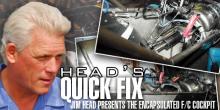JIM HEAD – INNOVATING FUNNY CAR CAPSULE
 John Force’s potentially fatal crash
really bothered Jim Head.
John Force’s potentially fatal crash
really bothered Jim Head.
The accident bothered him so much
that he said he spent hours, and he doesn’t exaggerate, hours watching tape of
the crash and analyzing what happened.
Head resolved to prevent the same
thing from happening again. Head was so intent in his efforts he was prepared to
be the lab rat in a high horsepower experiment.
Head flew to Indianapolis to look at
the remnants of the Force chassis. The thought of what could have happened
scared him enough to put his engineering education to
work.
“I’m not going to debate anyone’s
theories,” Head said. “I’m just going to build something safer for myself and if
anyone wants to look at it, more power to them. There are just too many opinions
and the debate doesn’t need another one.”
Head has designed one of the initial, if not the first, encapsulated Funny Car cockpits.
Always the innovator Jim Head makes a huge leap forward in Funny Car safety


The accident bothered him so much
that he said he spent hours, and he doesn’t exaggerate, hours watching tape of
the crash and analyzing what happened.
Head resolved to prevent the same
thing from happening again. Head was so intent in his efforts he was prepared to
be the lab rat in a high horsepower experiment.
Head flew to Indianapolis to look at
the remnants of the Force chassis. The thought of what could have happened
scared him enough to put his engineering education to
work.
“I’m not going to debate anyone’s
theories,” Head said. “I’m just going to build something safer for myself and if
anyone wants to look at it, more power to them. There are just too many opinions
and the debate doesn’t need another one.”
Head has designed one of the
initial, if not the first, encapsulated Funny Car
cockpits.
Head said this isn’t a shoe-horned
capsule. His driver’s capsule is fabricated with current and proven
technology.
“I reacted to what I saw on John Force’s chassis and adapted mine to not fail in the same fashion,” Head said. “I’m concerned about my safety as well as the person beside me. Force’s car smacked Kenny Bernstein pretty hard. Overall safety is paramount and I recognized the chassis was deficient but I didn’t realize to what extent until John’s car broke in half. I fixed mine but it is my fix.”
a d v e r t i s e m e n t
Click to visit our sponsor's website

“That’s the way most everything
works around here,” Head explained. “We talk throughout the project. But, it is
really a simple procedure. I went from being so uncomfortable with Funny Car
safety that I wasn’t planning to run
Basically, Head has strengthened
every area where he saw Force’s chassis had failed in Dallas. He’s added
titanium plate in every area that would expose the driver to harm. Head also
added extra tubing (4130 conditioned end tubing) over the existing joints to
strengthen what were considered vulnerable areas.
Davis, a welder since he was 15
years old, welded inserts over the top of the frame rail in order to spread the
load across the chassis. He also added titanium inserts and tabs and purposely
spaced them three inches for increased load balancing.
Davis said that he figured it took
him at least seven and a half minutes per each of the 75 tabs added. The total
project required two sixteen hour days of steady work to
complete.
Davis used the same type of tabs
that were employed on the chassis to add the titanium sheeting around the roll
cage. Despite the extra weight from all the tabs, Davis isn’t afraid the extra
pounds will affect the performance of the race car.
“Performance wise, if there is any
deficiency, I think we can tune around that,” Davis stated with confidence. “We
just recently went from a slip-tube car in the front and welded it up solid so
the car would steer solid. We didn’t see any performance loss
whatsoever.”
The additions give Head and Davis a more secure feeling with a chassis they both believed was made from “normalized” tubing and later discovered to be heat treated.
a d v e r t i s e m e n t
Click to visit our sponsor's website

Both Head and Davis said this is
just a makeshift fix for present. Over the winter,
Head said NHRA tech director Danny
Gracia approved his fix, saying that he
liked the design. On Saturday, NHRA officials paid a visit to Head’s pit area to
inspect his latest design.
Ready to skip the Richmond event
because of safety fears, Head acknowledged the completion of this project
changed his mind. And, after all, it’s his life on the line each time the race
car roars down the track. Who better to be concerned about his safety than
himself.

“There are way too many opinions out
there about these race cars and not nearly enough facts. One engineer is quoted
as doing this and that, others are doing other things. As far as I can see, none
of them are burning nitro. I’ve been doing this for thirty years and you learn a
lot.
“To me, engineering is the challenge
of drag racing. You’re always trying to move forward if you’re an innovator. You
don’t take things just because they are existing designs. You have to move
forward with newer and safer ideas.
“I hadn’t planned on doing a lot
more, but now I am dedicated to make these Funny Cars a lot better than they
have been.”
| {loadposition feedback} |




